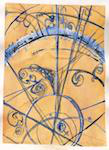Description
Antonio Ortiz, Klaus Werner
The CMS collaboration presents two talks on small-system physics. This contribution will focus specifically on the dependence of particle correlations on energy and multiplicity
Measurements of anisotropic flow provide an important insight into the nature of collectively expanding hot and dense strongly coupled matter in heavy-ion collisions. Over the past years, striking similarities were revealed in numerous experimental results measured in high-multiplicity proton-proton and proton-lead interactions, where no emergence of such a medium was expected.
In this talk,...
Electron-positron pairs produced in ultra-relativistic heavy-ion collisions at the LHC carry important information about the system space-time evolution unperturbed by strong final-state interactions. The dielectron continuum is very rich in physics sources: on top of Dalitz and resonance decays of pseudo-scalar and vector mesons, thermal black-body radiation contains the information about the...
High multiplicity events of small colliding systems at high c.m.s. energies show similar collective features to heavy ion collisions with comparable multiplicities, such as long-range near-side correlations and v_n coefficients [1]. Whether this behaviour may be attributed to the presence of a deconfined state in small systems is an open question. Recent analyses of pp and p-Pb collisions also...
Abstract: We present studies shedding light on the correlated hadron production. This is an important source of information about the early stages of hadron formation and is not yet understood from first principles. In this talk, we will present the measurement of Bose-Einstein correlations using the ATLAS detector along with an analysis of the momentum difference between charged hadrons in...
This talk summarize the results on two-particle angular correlations for charged particles emitted in $e^+e^−$ collisions data collected at 91 GeV with the ALEPH detector at LEP. With the archived data, the correlation functions are studied over a broad range of pseudorapidity $\eta$ and azimuthal angle $\phi$ with respect to the electron-positron beam axis and the event thrust axis....
We propose and carry a detailed study of an observable sensitive to different mechanisms of minijet production. The class of observables measures how the transverse momenta of hadrons produced in association with various trigger objects are balanced as a function of rapidity. It is shown that the observables are sensitive to the model parameters relevant for the minijet production mechanisms:...
Quarkonium (a bound state of $Q\bar{Q}$ pair) production as a function of charged-particle multiplicity has been measured in pp collisions at the LHC. They exhibit a non-trivial correlation that can lead to a better understanding of the multiple-parton interaction mechanism in the initial state of the collision as well as possible collective effects in small systems. The ALICE detector at the...
One of the key results of the LHC Run 1 was the observation of an enhanced production
of strange particles in high multiplicity pp and p-Pb collisions at 7 and 5.02 TeV, respectively.
In addition, the multiplicity dependent results on particle production in pp collisions allowed the discovery of collective-like behavior in small systems at the LHC.
In order to provide further insights into the...
The correlation of charmonium (and also of heavy quarks in general) production with the charged particle multiplicity is of high interest, as it could give new insight into the interplay between hard and soft mechanisms in particle production, both at parton level and at hadronization.
Experimental data shows an intriguing increase of the self-normalized J/ψ yield with multiplicity.
In this...
Multiple experimental measurements have shown strong indications of flow in small collision systems. In this talk, I will examine the selected theoretical models with latest as well as well hidden experimental results in small collisions systems. I will discuss which experimental ''evidence" is solid and which might be misinterpreted. In addition, I will show the potential of deep learning in...
One of the key signatures of collectivity in heavy-ion collisions is the appearance of a ridge structure over wide pseudorapidity interval. Recently it was also found in small collision systems such as proton-proton or proton-ion collisions which origin is still on debate. In this work, contributions from the geometry fluctuations in the initial-state in pp collisions to the ridge structure...
We develop a MPI based theory of ridge phenomena in `MPI, the origin of collectivity comes out to be quantum interference of different MPIs. We show that
in this approach we obtain a picture of ridge phenomena in pp collisions compatible both qualitatively and qualitatively with experimental data.
the talk is based on:
Collectivity from interference
Boris Blok (Technion), Christian D. Jäkel...
